It’s Champagne season—a line you might think indicates that this article is being published two weeks too late.
And sure, sparkling wines usually are reserved for toasting at Christmas and New Year’s. Once those holidays have passed, most people believe the season for them is over. For me, it’s just beginning, and it lasts all year.
There’s a method to my madness—though I consider it not madness but sanity. That’s because far too many domestic wines don’t have enough acidity for me and the foods I eat.
And at the heart of wine-and-food pairings is that the wine must have sufficient acid to work with food. But far too many chardonnays are soft; too many cabernets lack the structure. Sugar has become commonplace in sauvignon blanc.
Americans have a sweet tooth and U.S. wineries, notably on the West Coast, make sure many wines are sweet or ultra-soft. Sometimes it’s simply low acid. Other times, the wine has such high alcohol that it acts as a sweetening agent. Sometimes it’s actual sugar—including in some of the most popular red wines!
So, you may ask, what does this have to do with Champagne? Or fine-quality sparkling wine?
Quality bubbly cannot be made if the grapes are harvested too late, which compromises the critical element of acidity that is required to make it taste good. French Champagne, with the capital C to indicate that comes from that district, usually has sufficient acid to work with almost all forms of food.
So do top-rate domestic bubblies. I refer to wines called brut, a term that denotes a dry wine. They have sufficient acid to work with a wide variety of foods. The acidity can be counted on to help food taste better.
There are about four dozen top-flight sparkling wine producers in the United States that make exceptional sparklers. Most are slightly sweet to balance high acidity, and it’s that attractive balance that gives them such versatility.
One result is that I tend to drink a lot more sparkling wine with my meals than any other single wine, with the possible exception of riesling (a passion of mine!). After I am done evaluating 30 or 40 wines in a day, my go-to beverage is a beer or sparkling wine, and I have plenty to choose from!
It has recently been widely reported that the Champagne district in France has been hit with some pretty terrible weather, the results of which are extremely small harvests and some not-very-interesting flavors. This has reduced the size of the crop and has had the effect of driving prices even higher than they had been, and Champagne is always a prestigious product, so it commands a high price.
I tasted a good example of a fine-quality Champagne the other day and even though it was discounted, it still cost just over $40 per bottle!
California and other domestic sparkling wines can be really fascinating, especially because the fruit is more evident, and the wines tend to be a little bit more vibrant. And, of course, priced a lot more reasonably.
It is extremely difficult to list my favorite domestic bubblies because so many are exceptional. For everyday drinking, many discount stores carry exceptional sparkling wines for $20 to $30 per bottle, which is reasonable when you compare that to the average cost of a high-quality chardonnay.
The other nice thing about sparkling wine is that you really don’t need to worry about vintages. Most non-vintage bruts are made to be drinkable as soon as they hit the retail shelf.
I keep several bottles of sparkling wine from my favorite California houses on hand year-round. And if a friend happens to show up unexpectedly, and I pull one out, I occasionally hear, “What’s the occasion?”
Wine of the Week
Roederer Estate NV Brut, Anderson Valley, Mendocino County ($22): A classic California aroma of citrus, fresh pear, and trace hints of brioche grace the first sniff, and the taster is dry and yet not at all austere. The tiny bubbles are pinpoint, and the aftertaste is perfectly suited to be paired with various kinds of foods. Widely available, it is as good a bottle of sparkling wine as it is produced anywhere in the world.




